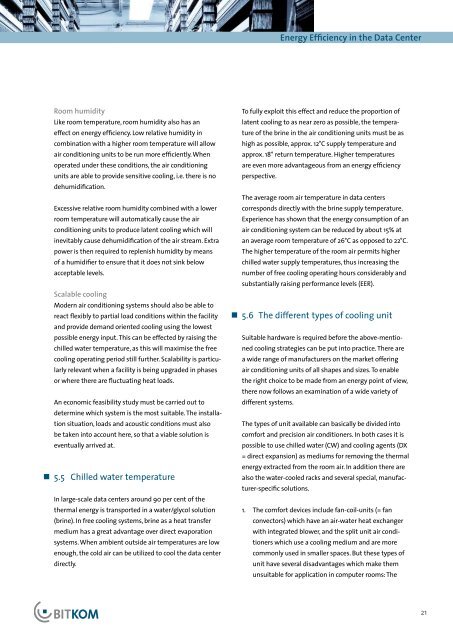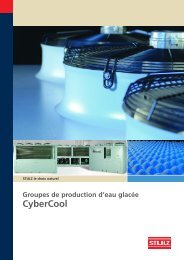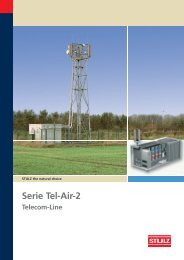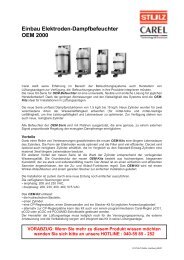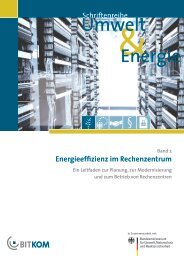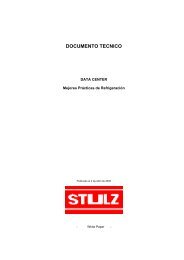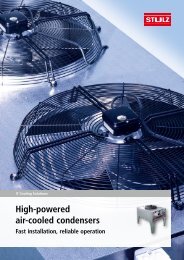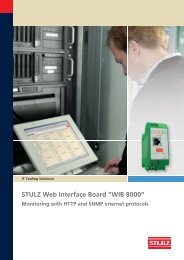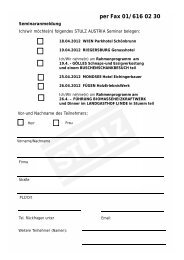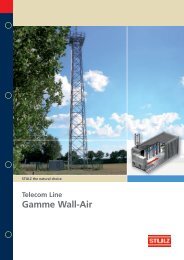Climate protection needs energy efficient data centers - Stulz GmbH
Climate protection needs energy efficient data centers - Stulz GmbH
Climate protection needs energy efficient data centers - Stulz GmbH
Create successful ePaper yourself
Turn your PDF publications into a flip-book with our unique Google optimized e-Paper software.
Energy Efficiency in the Data CenterRoom humidityLike room temperature, room humidity also has aneffect on <strong>energy</strong> efficiency. Low relative humidity incombination with a higher room temperature will allowair conditioning units to be run more <strong>efficient</strong>ly. Whenoperated under these conditions, the air conditioningunits are able to provide sensitive cooling, i.e. there is nodehumidification.Excessive relative room humidity combined with a lowerroom temperature will automatically cause the airconditioning units to produce latent cooling which willinevitably cause dehumidification of the air stream. Extrapower is then required to replenish humidity by meansof a humidifier to ensure that it does not sink belowacceptable levels.Scalable coolingModern air conditioning systems should also be able toreact flexibly to partial load conditions within the facilityand provide demand oriented cooling using the lowestpossible <strong>energy</strong> input. This can be effected by raising thechilled water temperature, as this will maximise the freecooling operating period still further. Scalability is particularlyrelevant when a facility is being upgraded in phasesor where there are fluctuating heat loads.An economic feasibility study must be carried out todetermine which system is the most suitable. The installationsituation, loads and acoustic conditions must alsobe taken into account here, so that a viable solution iseventually arrived at.• 5.5 Chilled water temperatureIn large-scale <strong>data</strong> <strong>centers</strong> around 90 per cent of thethermal <strong>energy</strong> is transported in a water/glycol solution(brine). In free cooling systems, brine as a heat transfermedium has a great advantage over direct evaporationsystems. When ambient outside air temperatures are lowenough, the cold air can be utilized to cool the <strong>data</strong> centerdirectly.To fully exploit this effect and reduce the proportion oflatent cooling to as near zero as possible, the temperatureof the brine in the air conditioning units must be ashigh as possible, approx. 12°C supply temperature andapprox. 18° return temperature. Higher temperaturesare even more advantageous from an <strong>energy</strong> efficiencyperspective.The average room air temperature in <strong>data</strong> <strong>centers</strong>corresponds directly with the brine supply temperature.Experience has shown that the <strong>energy</strong> consumption of anair conditioning system can be reduced by about 15% atan average room temperature of 26°C as opposed to 22°C.The higher temperature of the room air permits higherchilled water supply temperatures, thus increasing thenumber of free cooling operating hours considerably andsubstantially raising performance levels (EER).• 5.6 The different types of cooling unitSuitable hardware is required before the above-mentionedcooling strategies can be put into practice. There area wide range of manufacturers on the market offeringair conditioning units of all shapes and sizes. To enablethe right choice to be made from an <strong>energy</strong> point of view,there now follows an examination of a wide variety ofdifferent systems.The types of unit available can basically be divided intocomfort and precision air conditioners. In both cases it ispossible to use chilled water (CW) and cooling agents (DX= direct expansion) as mediums for removing the thermal<strong>energy</strong> extracted from the room air. In addition there arealso the water-cooled racks and several special, manufacturer-specificsolutions.1. The comfort devices include fan-coil-units (= fanconvectors) which have an air-water heat exchangerwith integrated blower, and the split unit air conditionerswhich use a cooling medium and are morecommonly used in smaller spaces. But these types ofunit have several disadvantages which make themunsuitable for application in computer rooms: The21


